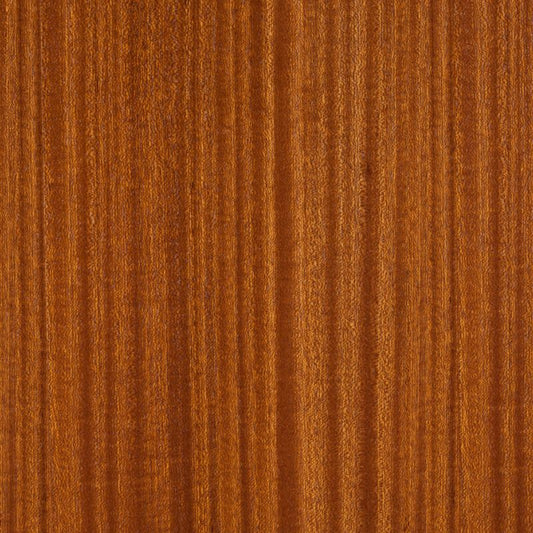Sapele Lumber
-
Sapele Hardwood Lumber Top Grade FAS - 25 bdft pack
Regular price From $200.00 USDRegular priceUnit price / per
Collection: Sapele Lumber
Common Trade Names: Sapele, sapelli, sapeli
Scientific Name: Entandrophragma cylindricum
Color Range: Golden to dark reddish-brown heartwood that darkens with age. It has interlocking grain patterns that may appear mottled, wavy, pomelle, quilted, beeswax or fiddleback.
Availability: widely available in regular lumber, figured lumber and decorative veneer
Janka Hardness Scale: 1,410 lbf
Average Weight per BF: 3.5 lbs/ Bd. Ft.
What Is Sapele Wood?
Sapele lumber rose to fame as an alternative to genuine mahogany (Sweitenia macrophylla) when the latter was frozen in the lumber trade. Sapele has a beautiful appearance and chatoyance that lends it an exotic look. Its interlocking patterns make it very durable and rot-resistance. However, it is also why it is not as excellently workable as other hardwoods.
But, the good thing about Sapele is the paint-grade property that lets it accept various finishes. It is also an affordable lumber available in great lengths and widths. With its hardness and dimension, Sapele became popular among door and window manufacturers.
Where Is Sapele Sourced From?
Sapele is a large tree indigenous to Africa's tropical regions. It is particularly abundant in the West from the Ivory Coast to Ghana, Nigeria, Cameroons, Uganda and Tanzania. Over the years, the demand for Sapele increased and, inversely, its population. It is a long-lived but slow-growing specie, and its large exploitation badly diminished its population by 20%.
Sapele lumber is now a vulnerable species on the IUCN Red List. The commercial exploitation of the Sapele wood is due to its beautiful and exotic figure. The dark tone and lustrous iridescence make it a prized wood for luxury flooring and musical instruments.
Is Sapele a Hardwood or Softwood?
Sapele is a hardwood or deciduous tree that loses its leaves during the dry winter. It is highly stable and rarely changes from the moment it is felled, kiln-dried and shipped for trading. As a hardwood, Sapele lumber has guaranteed high quality and great durability wood.
The problem with Sapele is its workability with a machine. Sapele is marked by regular stripes, occasional mottled figures, closed texture and interlocking grain pattern. It can dull the blade and cause tearouts. Despite this, the wood is excellent at taking nails, screws, glue and finishes well.
What to Look for When Purchasing Sapele?
Sapele lumber is often marketed under African mahogany, including a wide variety of wood from the mahogany family. This makes the lumber more expensive even if it remains unmatched in quality by the superior genuine mahogany.
The distinguishing feature of a Sapele is its tighter grain and pores. It is also harder and denser than other lumbers in its family. Freshly cut Sapele exudes a well-pronounced scent likened to a Spanish cedar.
A good Sapele lumber is not hard to find and is often available in 4/4 FAS grades. They come from large trees, so you can expect wider and thicker planks. The lumber has many color variations, but the rich and reddish-brown boards are the best for many projects.
FAQs
Is Sapele lumber sustainable?
Generally, Sapele is a highly sustainable material for its ability to remove and store carbon dioxide. But gauging from its life-cycle and overharvesting, they become less sustainable, especially when obtained from unsustainable sources.
How workable is Sapele?
Sapele is not very excellent regarding workability because of its rowed grain pattern. You will need freshly sharpened tools to work with it, but tearouts are inevitable. Sapele sands easily and accepts stains and finishes well.
Where can you use Sapele?
Sapele lumber is versatile. It is good for both outdoor and indoor projects, decorative furniture, musical instruments, turned objects and other specialty items. It is also most commonly used in windows, doors and floorings.
Where to Buy Sapele Lumber
Since Sapele is listed as a vulnerable species, sourcing them from legal traders is important. Sapele is still readily available anywhere after large-scale plantation projects. But, expect the price to be a little higher than it used to be.
For legally and sustainably-sourced Sapele lumber, check out Alderfer Lumber Company. We offer various sizes of premium quality Sapele that are properly milled and dried. They are well-documented and presented as Sapele. We assure you that you are getting the right lumber and not just any African mahogany lumber traded under the same name.
Alderfer also offers a wide variety of premium lumber, live edge slabs and reclaimed lumber. We believe that woodworking starts with the best lumber, so we exist as a one-stop shop for woodworkers. Give us a call today, and we will provide you with the right wood that you may be looking for.

